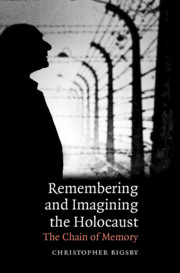Book contents
- Frontmatter
- Contents
- 1 The past remembered
- 2 W. G. Sebald: an act of restitution
- 3 Rolf Hochhuth: breaking the silence
- 4 Peter Weiss: the investigation
- 5 Arthur Miller: the rememberer
- 6 Anne Frank: everybody's heroine
- 7 Jean Améry: home and language
- 8 Primo Levi: from the darkness to the light
- 9 Elie Wiesel: to forget is to deny
- 10 Tadeusz Borowski: the world of stone
- 11 Memory theft
- Coda
- Notes
- Index
3 - Rolf Hochhuth: breaking the silence
Published online by Cambridge University Press: 22 September 2009
- Frontmatter
- Contents
- 1 The past remembered
- 2 W. G. Sebald: an act of restitution
- 3 Rolf Hochhuth: breaking the silence
- 4 Peter Weiss: the investigation
- 5 Arthur Miller: the rememberer
- 6 Anne Frank: everybody's heroine
- 7 Jean Améry: home and language
- 8 Primo Levi: from the darkness to the light
- 9 Elie Wiesel: to forget is to deny
- 10 Tadeusz Borowski: the world of stone
- 11 Memory theft
- Coda
- Notes
- Index
Summary
The world is silent. The world knows what is going on here – it cannot help but know, and in the Vatican, the deputy of God is silent, too.
From an underground Polish pamphlet, August 1943This statement, from another time, shaped into an accusation, opens the printed version of the third act of a play written by a thirty-two-year-old German author who as a child had been a member of the Deutsches Jungvolk, a Hitler youth group, the young members of which, in 1943, were set to collect leaflets dropped from Allied planes telling the Germans of the extermination of the Jews.
Rolf Hochhuth was born in 1931 in Eschwege, in Northern Hesse, the son of a man who worked in a shoe factory founded by his great-grandfather. That father had served in the First World War and went on, briefly, to serve in the second. Rolf met his wife-to-be while still at school. Her mother, a Social Democrat councillor, was removed by the Nazis, imprisoned and decapitated. Her father died while serving in the Wehrmacht.
Rolf's parents were anti-Nazi but had to keep their views to themselves. Their son, by contrast, looked for the German victory that they feared. Where W. G. Sebald protested that postwar Germans were silent about the catastrophe they had suffered, Hochhuth would be one of those who broke that silence, in 1964 observing that 'because of the bombing of the Allies, we hated the Allies … the English destroyed Kassel.
- Type
- Chapter
- Information
- Remembering and Imagining the HolocaustThe Chain of Memory, pp. 115 - 148Publisher: Cambridge University PressPrint publication year: 2006



